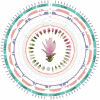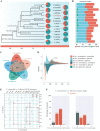The genomic and bulked segregant analysis of Curcuma alismatifolia revealed its diverse bract pigmentation
- PMID: 36304840
- PMCID: PMC9590460
- DOI: 10.1007/s42994-022-00081-6
The genomic and bulked segregant analysis of Curcuma alismatifolia revealed its diverse bract pigmentation
Abstract
Compared with most flowers where the showy part comprises specialized leaves (petals) directly subtending the reproductive structures, most Zingiberaceae species produce showy "flowers" through modifications of leaves (bracts) subtending the true flowers throughout an inflorescence. Curcuma alismatifolia, belonging to the Zingiberaceae family, a plant species originating from Southeast Asia, has become increasingly popular in the flower market worldwide because of its varied and esthetically pleasing bracts produced in different cultivars. Here, we present the chromosome-scale genome assembly of C. alismatifolia "Chiang Mai Pink" and explore the underlying mechanisms of bract pigmentation. Comparative genomic analysis revealed C. alismatifolia contains a residual signal of whole-genome duplication. Duplicated genes, including pigment-related genes, exhibit functional and structural differentiation resulting in diverse bract colors among C. alismatifolia cultivars. In addition, we identified the key genes that produce different colored bracts in C. alismatifolia, such as F3'5'H, DFR, ANS and several transcription factors for anthocyanin synthesis, as well as chlH and CAO in the chlorophyll synthesis pathway by conducting transcriptomic analysis, bulked segregant analysis using both DNA and RNA data, and population genomic analysis. This work provides data for understanding the mechanism of bract pigmentation and will accelerate breeding in developing novel cultivars with richly colored bracts in C. alismatifolia and related species. It is also important to understand the variation in the evolution of the Zingiberaceae family.
Supplementary information: The online version contains supplementary material available at 10.1007/s42994-022-00081-6.
Keywords: Anthocyanin synthesis; Floriculture; Genome evolution; Siam tulip; Zingiberaceae.
© The Author(s) 2022.
Conflict of interest statement
Conflict of interestThe authors declare that they have no conflict of interest.
Figures





Similar articles
-
Transcriptome Analysis Revealed the Anabolic Regulation of Chlorophyll and Carotenoids in Curcuma alismatifolia Bracts.Biochem Genet. 2024 Sep 26. doi: 10.1007/s10528-024-10923-1. Online ahead of print. Biochem Genet. 2024. PMID: 39327377
-
The Chromosome-Scale Assembly of the Curcuma alismatifolia Genome Provides Insight Into Anthocyanin and Terpenoid Biosynthesis.Front Plant Sci. 2022 Jun 15;13:899588. doi: 10.3389/fpls.2022.899588. eCollection 2022. Front Plant Sci. 2022. PMID: 35783929 Free PMC article.
-
Role of anthocyanin metabolic diversity in bract coloration of Curcuma alismatifolia varieties.Plant Physiol Biochem. 2024 Nov;216:109156. doi: 10.1016/j.plaphy.2024.109156. Epub 2024 Sep 26. Plant Physiol Biochem. 2024. PMID: 39341180
-
Molecular mechanisms underlying the diverse array of petal colors in chrysanthemum flowers.Breed Sci. 2018 Jan;68(1):119-127. doi: 10.1270/jsbbs.17075. Epub 2018 Feb 17. Breed Sci. 2018. PMID: 29681754 Free PMC article. Review.
-
[Progress in the genetic modification of blue flowers based on anthocyanin metabolism].Sheng Wu Gong Cheng Xue Bao. 2020 Apr 25;36(4):678-692. doi: 10.13345/j.cjb.190335. Sheng Wu Gong Cheng Xue Bao. 2020. PMID: 32347062 Review. Chinese.
Cited by
-
Cross-Compatibility in Interspecific Hybridization of Different Curcuma Accessions.Plants (Basel). 2023 May 11;12(10):1961. doi: 10.3390/plants12101961. Plants (Basel). 2023. PMID: 37653878 Free PMC article.
-
Identification and functional analysis of floral terpene synthase genes in Curcuma alismatifolia.Planta. 2024 Jun 11;260(1):26. doi: 10.1007/s00425-024-04440-z. Planta. 2024. PMID: 38861179
-
Ornamental Plants and Urban Gardening.Plants (Basel). 2023 Dec 7;12(24):4096. doi: 10.3390/plants12244096. Plants (Basel). 2023. PMID: 38140422 Free PMC article.
-
Chromosome-level genome and multi-omics analyses provide insights into the geo-herbalism properties of Alpinia oxyphylla.Front Plant Sci. 2023 Jun 8;14:1161257. doi: 10.3389/fpls.2023.1161257. eCollection 2023. Front Plant Sci. 2023. PMID: 37360712 Free PMC article.
-
The first complete mitochondrial genome of Curcuma amarissima (Zingiberaceae): insights into multi-branch structure, codon usage, and phylogenetic evolution.BMC Genomics. 2025 Apr 5;26(1):343. doi: 10.1186/s12864-025-11540-x. BMC Genomics. 2025. PMID: 40188039 Free PMC article.
References
-
- Akter R, Hasan R, Siddiqua SA, et al. Evaluation of analgesic and antioxidant potential of the leaves of Curcuma alismatifolia Gagnep. Stamford J Pharm Sci. 2008;1:3–9. doi: 10.3329/sjps.v1i1.1779. - DOI
LinkOut - more resources
Full Text Sources
Miscellaneous
